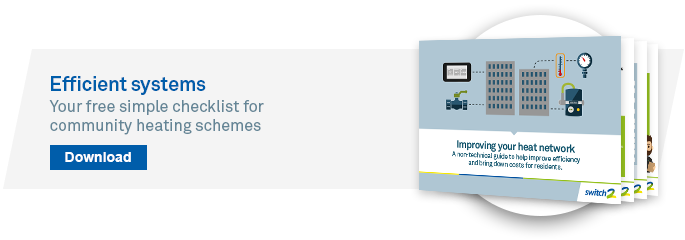Our latest SlideShare explains how smart metering can deliver exceptional levels of customer service across heat networks, while helping heat scheme owners and operators to reduce debt risk and comply with the latest regulations.
Heat networks: A solution to decarbonising heat
| 1909 | Smog claimed over 1,000 lives across Glasgow and Edinburgh |
| 1940's | Coal was distributed to each home by horse and cart across towns and cities |
| 1952 | The great smog of London (caused from coal fires) claimed over 4,000 people urging the Government to do more to clean the cities |
| 1960 | District heating gains momentum across the UK |
| 1970-80s | Gas in the Northern Sea is established and starts to be used across the UK - halting the uptake of district heating |
| 1990 - 00s | Climate change takes centre stage as a major concern globally |
| 2012 | Energy Efficiency Directive establishes a set of binding measures to help the EU reach its 20% energy efficiency target by 2020 |
| 2014 | The Heat Network (Metering and Billing) Regulations are put in place |
The spotlight is now on heat networks
There are many new initiatives that are putting heat networks centre stage:
- The Heat Network Regulations
- CIBSE/ADE Code of Practice CP1, providing minimum standards to design and operation of heat networks
- The Which? Report into customer protection
- The Heat Trust, providing protection and minimum standards to customers on heat networks
- The BEIS report into the heat networks consumer survey
- The CMA preliminary findings
But first, what is a heat network?
A heat network is the general term to describe both community and district heating networks. They take heat from a central source and distribute it to buildings and apartments within the network.
What is community heating?
Community heating is a centralised heating system that supplies heat and hot water to one building block with more than one heat customer.
Key issues: Uncovering the cracks
When things are not designed to the right loads of a heat network, many things can go wrong... here is just a few!
- High heat losses from pipework
- High operating temperatures
- Poorly sized plant
- Incorrect design
- Poor customer experience
- Poor handover
Key issues: The apartment heating system
The apartment heating system is a key issue that must be perfected. The issues can be split into two sections:
|
HARD Design and construction Operation and maintenance |
|
SOFT Knowledge and understanding of heat networks Transparency costs |
What is a smart meter?
A smart meter combines automatic meter reading with an in-home dispaly that allows residents to understand in real-time how much energy they are using.
Smart metering can contain the following:
Automatic meter reading: This could include half hourly or hourly reads being taken
In-home display - Providing transparency and information about their consumption history
Pay-as-you-go (PAYG) - Research shows that this is becoming increasingly popular! With 18-35 year olds preferring prepayment.
Customer Access Device (CAD) - A protocol that allows third party devices to exchange data with the SMETs smart metering system.
Are people ready for it?
Well, Switch2 statistics say yes!
- 1 in 4 residents are using our Switch2 app to make payments
- 89% overall customer satisfaction thanks to PAYG smart metering
- 59% of 18 - 34 year olds are interested in prepaying for their utilities
How is smart metering relevant?
- Accurate and timely bills
- Convenient PAYG
- In-home display
- Bringing together cost and control
- Data for scheme optimisation
Scheme optimisation
- Understand loads (peaks and troughs)
- Reducing temperatures (flow and return)
- Reducing pumping costs
Key takeaways
- The spotlight is on heat networks with the latest CMA report leading the way
- Smart metering, along with customer engagement can help deliver exceptional customer service
- They help to make heat networks transparent and flexible
- Reducing risks for scheme owners and operators such as; debt risk and help comply with the latest regulations



